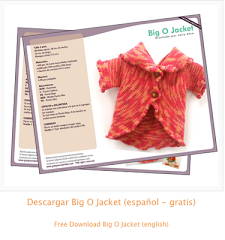Gauge is simply a measurement of the number of knitted or crocheted stitches and rows there are to an inch of fabric. Two knitters using the same materials may end up with different tensions. It's important to check your gauge before you start a project and see how your knitting compares to the gauge of your pattern. If your number of stitches and rows per inch doesn't match the pattern you are working with, the size of your finished product will be different from the pattern.
For some projects like scarfs this might not matter very much, but for something like a jacket it can make a big difference.
How to Knit a Gauge Swatch
When you knit a gauge swatch, you use the same pattern, yarn, and needles that you intend to use for your project.
Cast on about 6 inches worth of stitches, work the main pattern until the swatch measures 6 inches in length.
Bind off loosely or cut the strand of yarn, leaving an 8-inch tail. Draw it through the loops of the last row.
Block the swatch in the same manner you plan to use for your finished project.
Pin down the edges of the gauge swatch if they’re curling in, and be careful not to stretch your swatch.

1. For stitches, lay a ruler along a row of stitches and mark the beginning and end of 4 inches with pins.
2. Note the number of stitches in 4 inches.
3. For rows, lay your ruler along a vertical line of stitches.
Align the bottom of the ruler with the bottom of a stitch or row.
4. Put a pin in to show where the first stitch begins, then place another pin 4 inches up.
This step marks off the area that will represent your gauge.
5. Count the stitches between the pins and note the number of rows.
Check to see if your 4-inch gauge matches the one in the pattern.
Calculating the gauge of your swatch
The number of stitches ÷ the width of the swatch = stitches per inch
If you have more stitches per inch than the gauge suggests, that means you are working too tightly; try a larger needle or hook. If you have fewer stitches than the suggested gauge, your stitches are too loose; try a smaller needle or hook.
The number of rows ÷ the length of the swatch = rows per inch
To measure the rows, center a measuring tape or ruler lengthwise on the swatch, and count the number of rows over 2 inches, or 4 inches if the pattern is very large vertically. Normally have more rows per inch than stitches per inch.
If you have more or fewer stitches per inch than the gauge suggests but you really like the way the swatch feels as it is and you don't want to give up a softer or strict fabric by switching needles. So you grab the calculator and start writing your own version of the pattern to work with your yarn and your gauge.
Gauge / Tension
Publicado por Tejer Bien ![]()
Suscribirse a: Enviar comentarios (Atom)



0 comentarios:
Publicar un comentario en la entrada